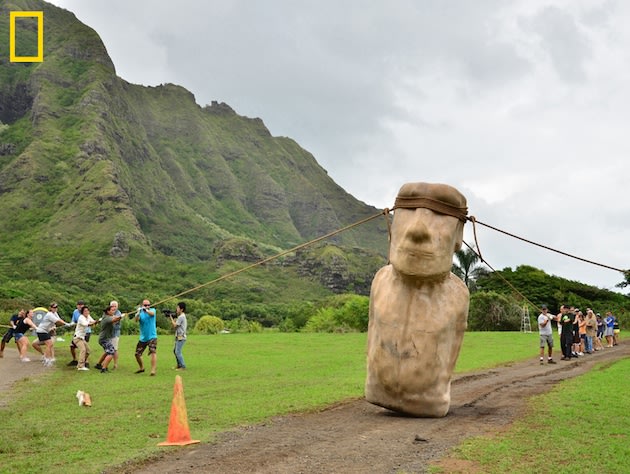 Researchers "walk" a replica of Easter Island's famous statues (Sheela Sharma/National Geographic)
Researchers "walk" a replica of Easter Island's famous statues (Sheela Sharma/National Geographic)
Were the giant statues on Easter Island actually "walked" to their final resting spots?
Researchers have unveiled a new theory that may redefine the historical understanding of how natives on Easter Island transported the iconic moai statues.
Writing in July's issue of National Geographic magazine, California State University at Long Beach archeologist Carl Lipo and Hawaii anthropologist Terry Hunt postulate that Polynesian natives used a system of ropes and manpower to walk the statues across the island.
"A lot of what people think they know about the island turns out to be not true," Lipo says.
Using the ropes, islanders would stand on each side of the statues, swaying them back and forth to create the walking effect.
Popular theory has held that the islanders created sled-like devices out of the island's trees to cart the statues. That theory also claims that deforestation from the island's inhabitants as part of the statue transporting process was directly tied to the population's eventual downfall.
Instead, Lipo and Hunt say the island's population was actually sustainable and instead fell victim to disease when European explorers first visited the island. In fact, Lipo said the cooperative effort involved in his transportation theory might have led to a more harmonious existence amongst Easter Island's inhabitants.
"You're actually putting a lot of your effort into the process of moving a statue rather than fighting," Lipo said. "Moving the moai was a little bit like playing a football game."
Jared Diamond, proponent of the sled transportation and subsequent deforestation theory, has disputed the new theory.
"This seems an implausible recipe for disaster," Diamond wrote in a post titled "The Myths of Easter Island" on Mark Lynas' blog. "Imagine it yourself: If you were told to transport a 90-ton statue 33 feet high over a dirt road, why would you risk tipping and breaking it by transporting it vertically with all its weight concentrated on its small base, rather than avoiding the risk of tipping by laying it flat and distributing its weight over its entire length?"
To counter Diamond's criticism, Lipo and Hunt attempted to recreate the walking method. They built a 5-ton moai replica (much smaller than the 90-ton Easter Island versions) and found the method worked quite well. And Hunt tells MSNBC that the theory applies to the larger statues as well.
"With the physics of the taller statue, you have greater leverage," he said. "It almost gets to the point where you would have to do it that way."
chris brown and rihanna nightline bloom box brady quinn brady quinn obama sweet home chicago accenture match play
No comments:
Post a Comment